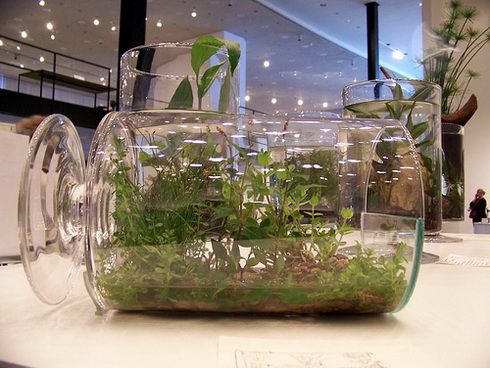|

Garden in a bottle - stylishly, fashionably, beautifully!
The fashion on these wonders keeps already for a couple of decades all over the world. It came in the beginning of 90s and since then gets more and more admires who transform their window sills into exotic minigardens. Besides the list of tiny plants which can be placed «in glass», also grows. Do you want to try your forces in making of a stylish gift? Well, the garden in a bottle is not so difficult…
The basis of any garden a bottle is a glass vessel - «Ward's box» or a large bottle with a narrow throat. The story of of such vessel occurrence is very interesting.
An ideal plant for landing in a bottle garden is fittonia F. microphylla (F. argyroneura f. nana), especially, its small leaves form which looks very nice in open minigardens accompanied with other mini plants - Selaginella, Pilea, dwarfish rubber plant, ferns, Nertera.
What and in what sequence everything needs to be done
The first thing is, to choose a decorative glass capacity in which the garden will be arranged. Then to make a funnel from a usual sheet of paper, than to fill up the bottle through the funnel with drainage - small claydite or gravel, and on top the dried soil mix from the cespitose earth and peat in the ratio 1:1 with charcoal addition. Then to justify the substratum surface.
After this you’ll need the great virtuosity in order to introduce the plant through the neck of your bottle. Fittonia is usually landed in a large bottle with the help of improvised tools - plugs and spoons to which for lengthening it is necessary to tape wooden sticks The Chinese sticks will perfectly suit for this role. At first it is necessary to make deepenings in which then cautiously to fix a plant. After landing it is necessary to slightly condense soil. For this purpose use a coil or a stopper, forced on a stick.
Now it is the time to wash internal walls of capacity with a sprayer. After that plants and soil should remain damp, but is not excessive.
Densely close the bottle. In the sealed vessel the humidity level will establish in one or two weeks. During this time on the internal walls of a bottle there will be moisture droplets - a condensate. If the moisture from walls does not disappear in any way, it means that it is too much of it there. In this case leave the bottle without stopper for a day and observe again. If the moisture does not condense at all, it is probably too chilly in the bottle. Then sprinkle the plants again and close the bottle.
Probably, it will be necessary from time to time to open the bottle and then to close it again. Do not forget to close the vessel after the glass becomes transparent. Further watering can be shown to a minimum as there will be enough moisture evaporating from the surface of leaves. So the self-regulated system is created. But it is possible not to close the capacity, if the neck is not too big. In such a vessel anyway will be a damp and protected atmosphere with a minimum of fluctuations, and Fittonias will perfectly feel theirselves.
|
